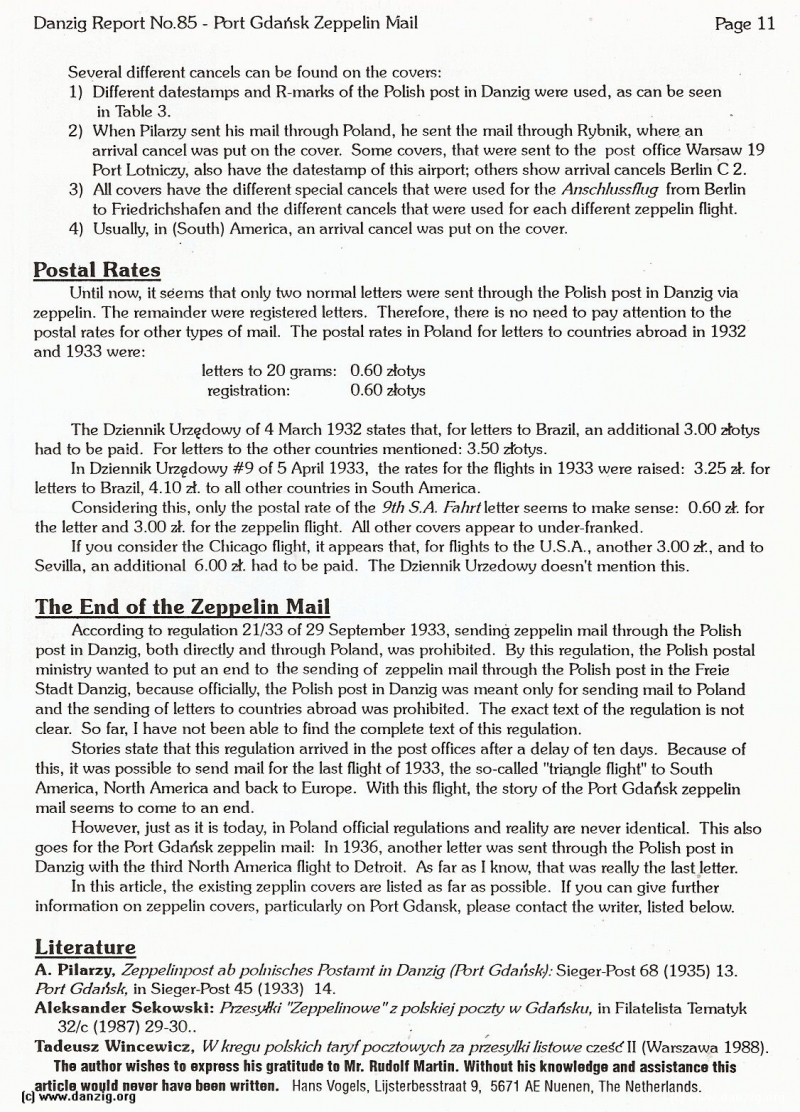
Several different cancels can be found on the covers:
1) Different datestamps and R-rnarks of the Polish post in Danzig were used, as can be seen in Table 3.
2) When Pilarzy sent his mail through Poland, he sent the mail through Rybnik, where an arrival cancel was put on the cover. Some covers, that were sent to the post office Warsaw 19 Port Lotniczy, also have the datestamp of this airport; others show arrival cancels Berlin C 2.
3) All covers have the different special cancels that were used for the Anschhissflug from Berlin to Friedrichshafen and the different cancels that were used for each different zeppelin flight.
4) Usually, in (South) America, an arrival cancel was put on the cover.
Postal Rates
Until now, it seems that only two normal letters were sent through the Polish post in Danzig via zeppelin. The remainder were registered letters. Therefore, there is no need to pay attention to the postal rates for other types of mail. The postal rates in Poland for letters to countries abroad in 1932 and 1933 were: letters to 20 grams: 0.60 zlotys registration: 0.60 zlotys
The Dziennik Urzçdowy of 4 March 1932 states that, for letters to Brazil, an additional 3.00 zlotys had to be paid. For letters to the other countries mentioned: 3.50 zlbtys.
In Dziennik Urzdowy #9 of 5 April 1933, the rates for the flights in 1933 were raised: 3.25 al. for letters to Brazil, 4.10 zI. to all other countries in South America.
Considering this, only the postal rate of the 9th S.A. Fahrt letter seems to make sense: 0.60 zI. for the letter and 3.00 zi. for the zeppelin flight. All other covers appear to under-franked.
If you consider the Chicago flight, it appears that, for flights to the U.S.A., another 3.00 zI’., and to Sevilla, an additional 6.00 zi. had to be paid. The Dziennik Urzedowy doesn’t mention this.
The End of the Zeppelin Mail
According to regulation 2 1/33 of 29 September 1933, sending zeppelin mail through the Polish post in Danzig, both directly and through Poland, was prohibited. By this regulation, the Polish postal ministry wanted to put an end to the sending of zeppelin mail through the Polish post in the Freie Stadt Danzig, because officially, the Polish post in Danzig was meant only for sending mail to Poland and the sending of letters to countries abroad was prohibited. The exact text of the regulation is not clear. So far, I have not been able to find the complete text of this regulation.
Stories state that this regulation arrived in the post offices after a delay of ten days. Because of this, it was possible to send mail for the last flight of 1933, the so-called “triangle flight” to South America, North America and back to Europe. With this flight, the story of the Port Gdatsk zeppelin mail seems to come to an end.
However, just as it is today, in Poland official regulations and reality are never identical. This also goes for the Port Gdaiisk zeppelin mail: In 1936, another letter was sent through the Polish post in Danzig with the third North America flight to Detroit. As far as I know, that was really the last letter.
In this article, the existing zepplin covers are listed as far as possible. If you can give further information on zeppelin covers, particularly on Port Gdansk, please contact the writer, listed below.
Literature
A. Pllarzy, Zeppelinpost ab polnisches Postami in Dan4g (Port Gdau;sk,1. Sieger-Post 68 (1935) 13. Port Gdaisk, in Sieger-Post 45 (1933) 14.
Aicksander Sekowskl: Pizesyiki ‘2’eppeliziowe”zpolskiejpoczty w Gdañsku, in Filatelista Tematyk 32/c (1987) 29-30..
Tndeusz Wlncewlcz, Wkregu poiskich tazyf pocztowych za pizesylkilistowe cze II (Warszawa 1988). The author wishes to express his gratitude to Mr. Rudolf Martin. Without his knowledge and assistance this article would never have been written. Hans Vogels, Lijsterbesstraat 9, 5671 AE Nuenen, The Netherlands.
Danzig Report Vol. 1 - Nr. 85 - October - November - December - 1994, Page 11.
Hits: 3443
Added: 10/07/2015
Copyright: 2025 Danzig.org

